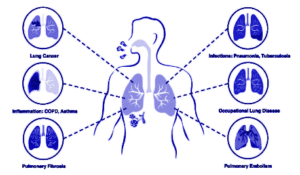
Courses

By Shailendra Singh
|
Updated on 27 Jan 2025, 11:01 IST
An occupational respiratory disorder can be described as any lung ailment that a person acquires when exposed to certain chemicals, toxins, or dust for a long time. Occupational exposure is the main cause of almost all respiratory disorders. The contribution of the work environment to the development and in enhancing the disease is still not recognized and is certainly under-reported. People are not aware of the severity of the disease. Government, media, and educated individuals should step ahead to make people aware of these diseases, and proper measures should be taken to avoid these disorders before it’s too late.
Occupational respiratory disorders are often seen in developed countries as they have more industries producing dust and hazardous gases. Materials that are breathed in the workplace can cause major chronic lung diseases. Because of the difference in the genetic constitution and metabolism, particular occupational agents may cause different host susceptibility. Smoking cigarettes have a different impact on other people. Asthma has become the most common chronic occupational lung disease in developed countries, such as Pneumoconiosis from silica or coal dust. Detecting a workplace-related cause of the occupational disorder is important to prevent and cure it.
Work-related lung diseases are lung conditions that are exacerbated by specific work environments. They are caused by long-term inhalation of certain irritants into the lungs. These lung diseases may have long-term consequences, even after exposure.
These lung problems are caused by particles in the air that come from various sources. Among the sources are factories, smokestacks, exhaust, fires, mining, construction, and agriculture. The smaller the particles, the greater the damage to the lungs. Smaller particles can be easily inhaled and penetrate deep into the lungs. Instead of being coughed out, they are absorbed into the body.

When some of the pollutants accumulate in the body beyond their normal concentration or are inhaled for long durations, they start to develop major symptoms, which are:
There is a complete list of disorders that can be acquired at workplaces. Some of them are quoted below-
For diagnosing occupational lung disorders, various tests and techniques are applied to analyze the type and severity of the disease based on symptoms arising in the affected individual’s body.
In the initial stages of diagnosis, usually, a chest X-ray or CT Scan is performed, after that further tests that can be performed are-
Biopsy or autopsy of tissue, cells, and fluids from the lungs (microscopic examination technique).

The tests are usually performed with special machines into which the person must breathe. Help measure the lungs’ ability to move air in and out of the lungs effectively.
The following factors are responsible which deciding the treatment or medication of occupational respiratory disorders-
An occupational respiratory disorder can be described as any lung ailment that a person acquires when exposed to certain chemicals, toxins, or dust for a long time.
Silica, Asbestos, Dust, Pollen grains, BCME, Polyaromatic hydrocarbons, Nanoparticles, Beryllium, Chromium, Cadmium, Coal dust, Smoke, etc.
Biopsy or autopsy, Biochemical and cellular studies of lung fluids, Measurement of respiratory or gas exchange functions, Examination of airway or bronchial activity, etc.